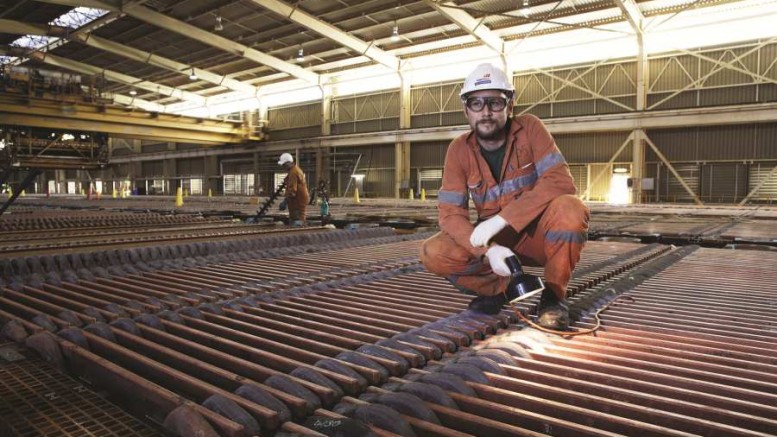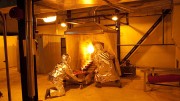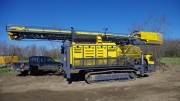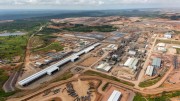VANCOUVER — Tapping into the IntelligenceMine database of our sister company Infomine, The Northern Miner has compiled the world’s five largest copper deposits at operating mines worldwide based on resources.
1. ESCONDIDA COMPLEX, CHILE

BHP Billiton’s Escondida copper mine in northern Chile. Credit: BHP Billiton.
The Escondida copper-gold porphyry complex is the world’s largest copper deposit, and sits 170 km due southeast of Antofagasta, Chile, at an elevation of 2,852 metres. The operation currently boasts a reserve life of roughly 86 years and generated 1.13 million tonnes of copper in 2015.

Escondida lies 170 km due southeast of Antofagasta, Chile, at an elevation of roughly 2,852 metres. Credit: Infomine.
As of June 2016, Escondida hosts measured and indicated resources of 10.8 billion tonnes grading 0.58% copper, or 62.4 million contained tonnes of the red metal. The porphyry deposit was weathered to form a high-grade secondary copper zone above the hypogene mineralization.
BHP Billiton (NYSE: BHP; ASX: BHP; LON: BLT) operates the Escondida mine with a 57.5% ownership interest. Rio Tinto (NYSE: RIO; LON: RIO) holds a 30% stake, while a Japanese consortium, headed by Mitsubishi, controls the remaining 12.5%. BHP greenlit a US$200-million expansion in 2016 to bump Escondida’s average annual production to 1.2 million tonnes copper.
Recent reports have warned that workers at the mine could go on strike in February pending the result of labour negotiations.
2. EL TENIENTE, CHILE

The Colihues tailings pond holds waste from Codelco’s El Teniente copper mine near Rancagua, Chile. Source: Amerigo Resources.
Santiago-based Codelco‘s underground El Teniente block-cave copper operation takes second place, and lies 31 km northeast of Rancagua, in central Chile, at an elevation of 2,049 metres.
The operation produced 473,000 tonnes of copper in 2015, while current numbers indicate the reserve life now sits at 31 years. As of December 2015, El Teniente’s measured and indicated resources total 8.14 billion tonnes at 0.67% copper for 54.21 million contained tonnes.

The El Teniente block-cave copper operation lies around 31 km northeast of Rancagua in central Chile. Credit: Infomine.
The project is a typical porphyry copper-molybdenum deposit-in terms of its alteration and sulfide assemblage zonation, association with felsic intrusions, and predominance of quartz vein-hosted copper mineralization.
Codelco expects the mine to meet 2016 guidance of roughly 466,000 tonnes copper despite some weather issues that forced a brief halt in operations in April.
3. OLYMPIC DAM, AUSTRALIA

Facilities at BHP Billiton’s Olympic Dam copper-uranium-gold mine in South Australia, where the company has delayed a US$30-billion expansion amid rising capital costs. Source: BHP Billiton.
BHP Billiton makes another appearance on the list with its Olympic Dam iron oxide copper-gold (IOCG) deposit 14 km north of Roxby Downs, Australia. The underground, long-hole operation produced 152,300 tonnes copper and 104,500 oz. gold in 2015. As of June 2016, Olympic Dam hosts measured and indicated resources of 6.2 billion tonnes averaging 0.82% copper for 50.6 million contained tonnes.
The deposit occurs in the basement rocks of the Stuart Shelf geological province in the north of South Australia, west of Lake Torrens. Mineralization consists of medium-grained chalcopyrite, bornite and chalcocite, fine-grained disseminated pitchblende, gold, silver and rare earth minerals that occur in a magnetic hydrothermal breccia complex beneath 350 metres of overburden.

The Olympic Dam iron oxide copper-gold (IOCG) deposit sits 14 km north of Roxby Downs, Australia. Credit: Infomine.
In July 2016, BHP shelved a planned US$30-billion redevelopment of Olympic Dam due to high capital costs and low commodity prices. The company indicated it now intends to boost production to 230,000 tonnes copper annually over the next five years, but could expand the operation to 450,00 tonnes per year copper if market conditions improve.
4. Collahuasi, Chile

The Collahuasi porphyry-copper deposit 152 km southeast of Iquique, Chile. Credit: Minera Dona Ines de Collahuasi.
European majors Anglo American (LON: AAL) and Glencore (LON: GLEN) rank fourth with the Collahuasi porphyry-copper deposit 152 km southeast of Iquique at an elevation of 4,354 metres. The project produced 455,300 tonnes copper in 2015 via heap leach and solvent extraction and electrowinning (SX/EW) processing technologies.
Collahuasi is a copper (porphyry and veins) deposit, with additional occurrences of molybdenum and silver. The project has a 38-year reserve life, and hosts measured and indicated resources of 5.1 billion tonnes at 0.82% copper for 41.7 million contained tonnes according to technical documents dated December 2015.

The Collahuasi porphyry-copper deposit sits at an elevation of 4,354 metres. Credit: Minera Dona Ines de Collahuasi. Credit: Infomine.
In May 2016, Anglo and Glencore partnered with Canadian major Teck Resources (TSX: TCK.B, NYSE: TCK) to share resources and infrastructure. Teck operates the nearby Quebrada Blanca mine.
5. ANDINA, CHILE

The Andina operation sits 38 km east of the city of Colina in the Chacabuco Province. Credit: ATC Williams.
Codelco strikes again courtesy of its Andina mine, which encompasses a mineralized zone extending towards Anglo’s Los Bronces mine peripherie, and representing one of Chile’s largest copper assets. The operation sits 38 km east of the city of Colina in the Chacabuco Province at 3,572 metres elevation, and produced 225,000 tonnes copper in 2015.

Andina produced 225,000 tonnes copper in 2015. Credit: Infomine.
As of December 2015, Andina has measured and indicated resources of 5.4 billion tonnes grading 0.71% copper for 38.3 million contained tonnes. In late 2015, Codelco approved a US$7.5-billion expansion of the mine that is expected to take approximately two years.





Be the first to comment on "TNM Data Miner: Top 5 global copper resources in 2016"